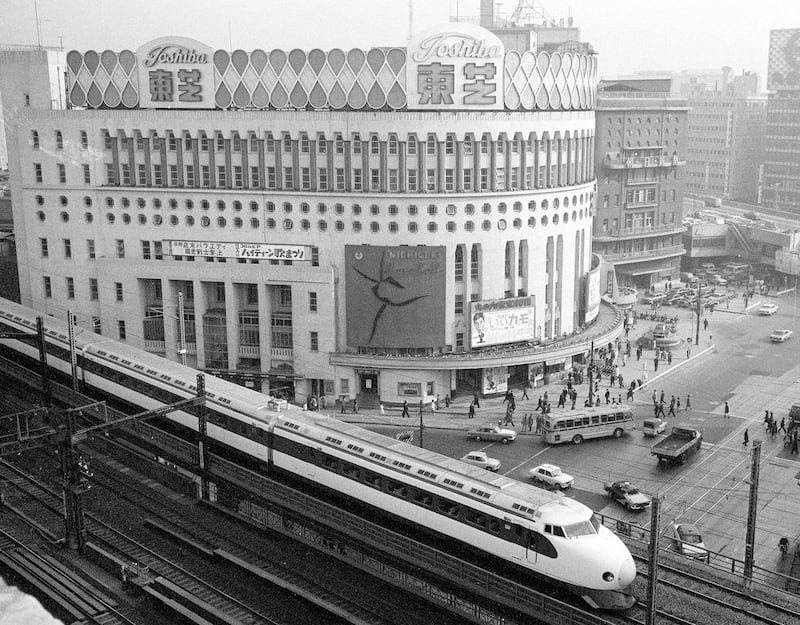Britain may have invented the steam locomotive and Germany the electric tram but Japan can viably claim to be the original home of high-speed rail travel.
In 1964, Japan Railways Group unveiled the first Shinkansen or “bullet train” rail service. In the intervening half-century, the network has blossomed like a Japanese cherry tree.
It now stretches from Kagoshima in the south, to Sapporo on the northern island of Hokkaido, carrying trains along at speeds of up to 320kph.
The Shinkansen was in the news again in the first week this month, as analysts and investors absorbed the ramifications of the latest plan to inject momentum into Japan’s growth-phobic economy.
Unveiling a ¥28.1 trillion (Dh1.02 billion) stimulus package, the premier Shinzo Abe pledged to bring forward the deadline on a super-fast magnetic levitation (maglev) train service, slated to connect Tokyo with the southern city of Nagoya by 2027, and with Osaka by 2045, cutting the total journey time from nearly three hours to a little over 60 minutes.
Central Japan Railway Company (JR Central), which will build the 410km line, expects the Tokyo-Nagoya segment of the route to cost ¥9tn, with the extension to Osaka costing a further ¥5.5tn. Mr Abe wants to extend low-interest loans, generated by government agencies and through debt instruments issued under the aegis of the stimulus package, to JR Central, with the aim of completing Chuo Shinkansen, as the country’s first maglev line is known, by 2037, eight years earlier than originally planned.
In some countries, this would seem an exorbitant and even wasteful use of money. Allied to its eye-watering cost, the new line will be a nightmare to build, with more than 80 per cent of the route set to go through mountain tunnels, which will need to be excavated from scratch.
Moreover, there is already a perfectly good Shinkansen line linking Tokyo with Osaka. It is, in fact, the world’s busiest rail service, carrying 151 million passengers a year. The new maglev service would be far whizzier – a test service trialled on a short stretch of track near Mount Fuji in April 2015 reached record speeds of 603km an hour.
Takashi Miwa, the chief Japan economist at Nomura, warns that the project’s distant deadlines mean there is little chance of “any short-term positive impact” spilling over into the wider economy.
Yet to Japanese citizens, the Shinkansen is part of the nation’s identity, a visible and iconic totem that embodies a nation’s rise from bitter military defeat to industrial and technological powerhouse. To Mr Abe and his countryfolk, to invest in the bullet train is to invest in the country’s past, present and future.
And there are a brace of other reasons to explain the premier’s sudden urgency to accelerate this huge engineering project.
First, tourism. Japan’s government hopes to more than double the number of people visiting the country on an annual basis, to 40 million by 2020, the same year that Tokyo hosts its second Olympic Games. (In a neat twist of fate, the Games first came to the capital in 1964, the same year the first bullet train was introduced).
Japan also hopes to boost the number of visitors arriving by cruise ship to 5 million by 2020, from 1.1 million in 2015. A significant number of tourists are expected to be mainland Chinese, who make up a quarter of all inbound tourists.
Many if not most will use the various Shinkansen lines to travel around. And once it is built, the Chuo Shinkansen maglev is likely to become a tourist attraction in its own right.
The other, far more strategic reason to build the new line, is that rail-related technology and infrastructure is one of the country’s biggest – and proudest – exports.
In December 2015, the Indian government signed a US$14.7bn deal with Japan to build the south Asian country’s first high-speed rail line, linking Mumbai with Ahmedabad. The deal was sealed after Japan agreed to provide technical assistance, and to finance the project with a super-cheap loan – $12bn, extended over 50 years, at 0.1 per cent interest.
Japan’s chief long-term rival in this industry is China, which recently cut a deal to build a high-speed rail service in Indonesia.
Tokyo and Beijing are competing head-to-head to secure rail contracts in a number of countries, from Thailand to the United States. The battle is complex and laden with historical meaning; to both sides, it is a proxy for industrial preeminence and political influence in Asia.
Little wonder Mr Abe included the first ever maglev Shinkansen in his latest mammoth fiscal stimulus package. It means a great deal, both in terms of how the world views Japan, and how the country sees itself.
business@thenational.ae





